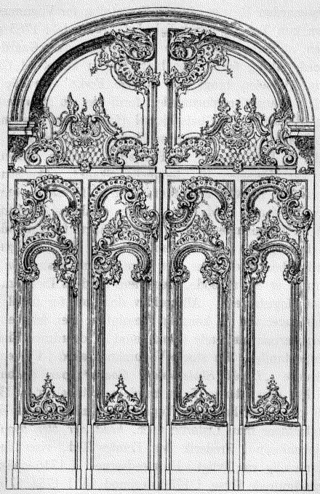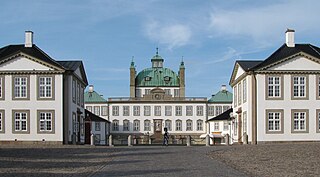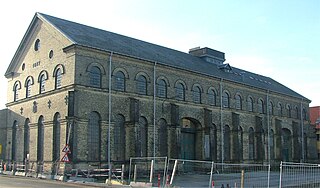Until 1 January 2007 Fredensborg-Humlebæk Kommune was a municipality on the east coast of the island of Zealand (Sjælland) in eastern Denmark. The municipality covered an area of 72 km², and had a total population of 20,024 (2005). Its last mayor was John Hemming, a member of the Conservative People's Party political party. The site of its municipal council was in Fredensborg. The municipality was a conglomerate of several small towns, the two major ones being Fredensborg and Humlebæk.

Frederick IV was King of Denmark and Norway from 1699 until his death. Frederick was the son of Christian V of Denmark-Norway and his wife Charlotte Amalie of Hesse-Kassel.

Hillerød is a Danish town with a population of 36,043 located in the centre of North Zealand approximately 30 km to the north of Copenhagen, Denmark. Hillerød is the administrative centre of Hillerød Municipality and also the administrative seat of Region Hovedstaden, one of the five regions in Denmark. It is most known for its large Renaissance castle, Frederiksborg Castle, now home to the Museum of National History. Hillerød station is the terminus of one of the radials of the S-train network as well as several local railway lines. The town is surrounded by the former royal forests of Gribskov to the north and Store Dyrehave to the south.

Christiansborg Palace is a palace and government building on the islet of Slotsholmen in central Copenhagen, Denmark. It is the seat of the Danish Parliament, the Danish Prime Minister's Office, and the Supreme Court of Denmark. Also, several parts of the palace are used by the Danish monarch, including the Royal Reception Rooms, the Palace Chapel and the Royal Stables.

Frederiksberg Gardens is one of the largest and most attractive greenspaces in Copenhagen, Denmark. Together with the adjacent Søndermarken it forms a green area of 64 hectares at the western edge of Inner Copenhagen. It is a romantic landscape garden designed in the English style.

Nicolai Eigtved, also known as Niels Eigtved, was a Danish architect. He introduced and was the leading proponent of the French rococo or late baroque style in Danish architecture during the 1730s–1740s. He designed and built some of the most prominent buildings of his time, a number of which still stand to this day. He also played an important role in the establishment of the Royal Danish Academy of Art, and was its first native-born leader.

Fredensborg Palace is a palace located on the eastern shore of Lake Esrum in Fredensborg on the island of Zealand (Sjælland) in Denmark. It is the Danish royal family’s spring and autumn residence, and is often the site of important state visits and events in the royal family. It is the most used of the royal family’s residences.

The architecture of Copenhagen in Denmark is characterised by a wide variety of styles, progressing through Christian IV's early 17th century landmarks and the elegant 17th century mansions and palaces of Frederiksstaden, to the late 19th century residential boroughs and cultural institutions to the modernistic contribution of the 20th century such as Arne Jacobsen's National Bank and SAS Royal Hotel.

Royal Huisman is a Dutch shipbuilding company that specializes in the newbuild construction and refit, rebuild and renewal of sailing and motor yachts.

Holmen is a water-bound neighbourhood in Copenhagen, Denmark, occupying the former grounds of the Royal Naval Base and Dockyards. In spite of its name, deceptively in singular, Holmen is a congregation of small islands, forming a north-eastern extension of Christianshavn between Zealand and the northern tip of Amager.

North Zealand, also North Sealand, refers to the northern part of the Danish island of Zealand which is not clearly defined but generally covers the area north of Copenhagen. The Danish tourist authorities have recently introduced the term Danish Riviera to cover the area in view of its increasing importance for tourism. The area has three royal castles and offers resorts with beaches, as well as lakes and forests. In addition to Kronborg Castle, three of the North Zealand forest areas used for royal par force hunting are included in the UNESCO World Heritage List.

Christian IV's Arsenal, is a historic building on Slotsholmen in central Copenhagen, Denmark. It was built by Christian IV of Denmark in 1604 as part of a grand scheme for the construction of a new naval harbour. The arsenal, along with several other buildings, surrounded the harbour basin which was connected to the main harbour by a narrow canal. Later, when ships became too large to enter the harbour, the fleet moved to Bremerholm and the decommissioned naval harbour was later filled in.

Lake Esrum is the largest lake in Denmark by water volume and the second-largest lake by surface area, after lake Arresø. It is situated in the central part of North Zealand, straddling the boundaries of the municipalities Hillerød, Fredensborg, Helsingør and Gribskov, some 40 kilometres north of Copenhagen.

Refshaleøen is a former industrial site in the harbor of Copenhagen, Denmark originally on a separate island but now annexed to the larger island of Amager. For more than a hundred years, it was home to the shipyard Burmeister & Wain which closed in 1996.

Applebyes Plads is a triangular area located between Langebro Bridge and the southernmost portion of Christianshavn Canal at the southern tip of the Christianshavn neighbourhood in Copenhagen, Denmark. The area takes its name from Peter Applebye, Christian VI's rope maker, who ran his manufactury from the site in the late 18th century, although no buildings remain from that time. The Danish Sugar Factories' building along the waterfront dates from 1912 while the rest of the grounds have undergone residential redevelopment in later years.

Orlogsværftet was a Danish naval shipyard under the Royal Danish Navy. Before 1924, it was an integral part of the naval base at Holmen in central Copenhagen, Denmark, with an independent management from 1692 when Olaus Judichær became the first factory director.

Tikøb is a small town and parish located 8 km west of Helsingør and six km north of Fredensborg, between Lake Esrum to the southwest and Gurre Lake to the east. in Helsingør Municipality, some 40 km north of Copenhagen, Denmark.

The park of Frederiksborg Castle is located to the north and west of Frederiksborg Castle in Hillerød, Denmark. It consists of a formal Baroque garden and a Romantic landscape garden.

Villa Gallina is a house situated outside the main entrance to Fredensborg Palace in Fredensborg, Denmark. It was listed in the Danish registry of protected buildings and places in 1918.
























